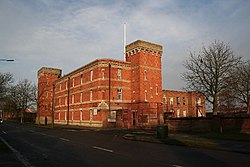| Sobraon Barracks | |
|---|---|
| Lincoln | |
 Sobraon Barracks | |
| Site information | |
| Type | Barracks |
| Owner | Ministry of Defence |
| Operator | |
| Location | |
| Coordinates | 53°14′59″N00°33′19″W / 53.24972°N 0.55528°W |
| Site history | |
| Built | 1890 |
| Built for | War Office |
| In use | 1890-Present |
| Garrison information | |
| Occupants | Royal Lincolnshire Regiment (Former), 160 (Lincoln) Squadron Royal Logistic Corps (Current) |
Sobraon Barracks is a military installation in Lincoln, England. It is currently occupied by the 160 (Lincoln) Squadron Royal Logistic Corps and Lincolnshire Army Cadet Force.
